
WebLetter 14
An Occasional Publication for the Home Boat Builder
Glen-L Marine Designs - 9152 Rosecrans Ave. - Bellflower, CA 90706
In this issue
- Feedback: Sweet Caroline
- Missile on the web
- More wood
- Builder feedback: Bo-Jest
- Report from the "dory man of Fiji"
- Book review: "The Dory Book" by John Gardner
- Marine plywood specifications
- Recent email
Glen-L Update
Website:
- On September 20th we received a 15MB email, which froze our email program.
The message contained photos of a customer's boat. A few
hints for emailing photographs:
- The standard resolution for internet publishing is 72 dpi. If you send photographs at higher resolution, they can take much longer to load so we will reduce them to 72 dpi.
- Size: We do not publish any photos larger that 600 pixels wide or 400 pixels in height. Larger photos take longer to load and will be reduced to fit the screen and to speed load time.
- If you have large numbers of photos it is best to send them in multiple emails. If they have been sized as described above, limit to 5 per email. If they have not been sized as above, send 1 or 2 per email.
- We use PC's and normally publish in .jpg format.
- We have added "Wood & Plywood" pages to the site to help builders understand plywood grades and to help in selecting lumber for boat building. We have included "Chapter 5 - Lumber" from our book "Boatbuilding with Plywood".
- Many new photos have been added to the Customer Photos section. The letters and emails with the pictures frequently include building notes; if you are interested in finding out more about a particular design, be sure to check these pages.
- We have added new "Plans for rowing" pages to the Boat Design Catalog. This is the same format as the "Plans for paddle" pages. Gradually all pages will be updated. Each page will have a link to the Bill of Materials for the boat. The Bills of Materials are not currently on the computer so have to be typed then formatted for the internet. The next section will be "Sailboats"; we hope to have it ready within two months.
- Would you like to become Internet famous? We are looking for articles, boat building hints, and photos for future WebLetters. The point of this WebLetter is to be a resource for boat builders... why not put in your two cents worth? How about "Shop Talk" about a particular procedure, special jigs you have made, or the right tool to use?
- Work on the PowerYak test model is almost complete and we should have it in the water next week. See more about the PowerYak in the NEW/Now on the drawing board pages.
Barry
Witt
Editor
Feedback: Sweet Caroline
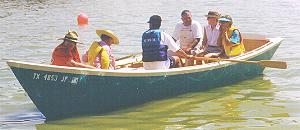
Letter:
Glen-L Marine
To whom it may concern:
This is the Sweet Caroline & full crew, re-named "Emma". She's beautiful. Thanks for all your help.
Sincerely
Gilbert Gonzalez
Mr. Gonzalez is a teacher at Raymond Telles Academy in El Paso, Texas. His class has just ordered plans for the IMP. We hope to hear reports on their project as it progresses. There is a larger version of the above photo and an additional photo in the Customers Photos/Archives pages.
Missile photos on the web
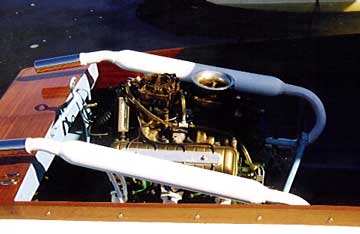
If you read our WebLetters regularly you may remember in WebLetter 12 that I asked for information on a photo of the Missile we had received; well, here it is.
Subject: FYI--a Missile
Thought you might like to see one of your old projects. I do work with this
site in Minneapolis-- www.Bristol-classics-ltd.com/glenl.htm
Gary Baker end of email
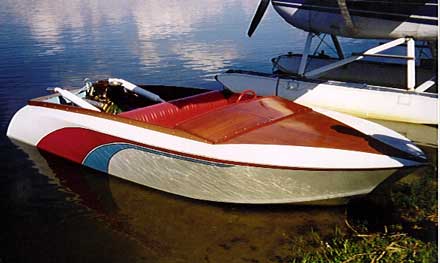
I had contacted the site owners and asked for permission to use the photos and was only reminded where these photos came from when my email was answered a month and a half later. The owners of this site do restorations, so I assume they restored the boat. It's a beautiful job, but it would be nice if they offered more information on their web site.
Wood - a continuing discussion
E-mail question: I can't get mahogany, white oak or spruce; can I use poplar?
Answer: Boats have successfully been built using all sorts of woods that are not recommended for boat building. But when we're asked to recommend a wood or alternative wood, we pick from a standard list. In our plans, we don't generally list long-leaf yellow pine as an option, because it's not available here. It fact, it is a good option and frequently used as an alternative to white oak. Like Douglas-fir, there are caveats about yellow pine. Both woods, in the areas where they are common, are used for home construction. Construction grades are not acceptable for boat construction, both from a quality standpoint and because they are not properly dried. Yellow pine is also a generic term which encompasses a variety of woods. The experts recommend "long-leaf" and some specify "old growth". "Straight grain" is specified for many types of wood, particularly Douglas-fir, because it is dimensionally more stable and has better strength characteristics.
Before this century, when wooden boatbuilding (like many crafts) was an art, boat builders would take great care in selecting their lumber. Today, in a world of consolidation of suppliers and rushed life styles, many home boat builders contact us to ask if they can use woods that really aren't suitable for the wet environment in which boats spend much of their life. In many cases, the caller went to their local building supply store and found that specialty woods were not available. The woods may have been available in lumberyards or from local specialty suppliers, but they had not taken the time to look. "Can I use red oak instead of white oak?" Red oak is not as rot resistant as white oak and is not recommended... can it be used? As Allyn (our shop foreman) is fond of saying, "It ain't my boat". We can give recommendations, but it is up to the builder to decide what to use.
Which non-marine woods could be substituted depends on how the boat will be used. You always want wood that is properly dried, free of knots or other structural defects, but what if this is a duck boat you keep in the garage and only take out a couple of weeks a year? If it is well painted, do you really have to worry about rot? Probably not. Clear red oak would be an option, albeit heavy, for a boat you might have to carry any distance. Western pines tend to be relatively weak and prone to rot. If you are building a small rowboat that you use as a coffee table, pine would be fine. If it's kept inside and only taken out occassionally... how about used frequently, but stored dry in a garage.., how about stored under a cover in the back yard? When you build a boat and you know how it is built and what its limitations are, then you will presumably treat it accordingly. But if you give it to someone else who hasn't decided in advance the limitation he would accept, your pine boat may be very short lived.
We have added a new section to our website, "Wood & Plywood" pages in which we have reproduced Chapter 5 from our book Boatbuilding with Plywood. This chapter discusses woods used in boat building. We hope to add additional features to this section concerning various types of wood that we have been asked about, listing information to help a potential boat builder decide what wood to use. Maybe in the future we will be able to tell anyone who asks about poplar why it is not listed as a desireable wood for boat building.
Feedback: Bo-Jest
Letter:
Sept. 24, 1999
To: Glen, Gayle, & Barry
Subject: Bo-Jest
Enclosed find a few pics of my latest "Glen-L" project. The notes on the back are kind of a story book of progress, success & problems.
A little history: My first was the Pee Wee in 1970, I still have it. Started the Escapade, never finished it, too much boat, too little money. Then (3) Eight Balls, the Sweet Caroline, and now the Bo-Jest.
You can't believe the number of calls I receive about the Caroline and Bo-Jest; both phone and internet.
It's fun, I'm retired, I think I enjoy building more than boating. I'm a snow bird now, in fact, I'm the bearded guy that stopped by your place on Monday 9/20(99).
Thanks for all the boat building stuff I've done over the last 30 years.
Sincerely,
Bob Ellis
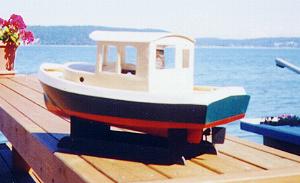 Photo 1
Photo 1
This is my 1" = 1' model. I have done this every time to make sure
I understand your plans and instructions.
(The background is Camano Is. I live on Whidbey Is. about 30 miles and a ferry
ride from Seattle.)
Feedback from the "Dory man of Fiji"
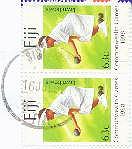
3/7/99
Dear Sir,
Thanks very much for helping me with my boat building endeavours which all turned out 100% successful. I built your 16 foot rowing dory for my two sons to fish out of, then built your St Pierre for a friend from Austrailia which is fishing full time out of Laiutoka and bringing in good catches of deep sea snapper every day. Finally I built the Drifter for myself, which is a dream boat.
The person that helps you the most, you tend to forget most, so I hope that this letter helps to rectify this. Your boat plans made it so easy with the step by step instructions, it made all of my dreams come true. All of the above boats turned out a work of art thanks to you. Since then I have repaired 4 other fishing boats which brought me in extra income.
All of the dories have very beautiful lines. You can't
get this type of information out here in Fiji, so again thanks to your company
for helping builders like myself start on the right track first up.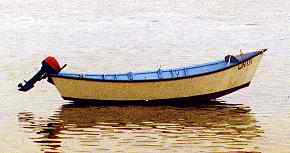 My Drifter handles the big swells very good outside
the reef near my house; actually handles much better than your description in
your marine book, really unbelievable in the the big seas and swells here and
the 10 hp Mercury pushes it along at a good steady speed. You feel so safe in
it, with good freeboard. I was surprised it was so easy to row and the 10 hp is
so cheap to run. I only use 1 1/2 litres per trip, which is nothing. Many
thanks again.
My Drifter handles the big swells very good outside
the reef near my house; actually handles much better than your description in
your marine book, really unbelievable in the the big seas and swells here and
the 10 hp Mercury pushes it along at a good steady speed. You feel so safe in
it, with good freeboard. I was surprised it was so easy to row and the 10 hp is
so cheap to run. I only use 1 1/2 litres per trip, which is nothing. Many
thanks again.
I have been asked by so many people here, who built this boat, the answer "I did it myself", which gives you a lot of pride.
I also got a lot of history on dories from the Smithsonian Institution in DC, from the transport marine section. Mr. John Kilina dug up so much history on dories for me, I didn't know that dories went so far back, it was so interesting to read about the history. I told him that I was building dories from plans from your company and he was delighted with the finished boats. Now he calls me the dory man of Fiji. He advised me to buy The Dory Book by John Gardner, it had so much information. On page number 243 he has a dory drawn that shows two small keels, so I did the same on my Drifter. It made it handle so well in the open sea. The Drifter sure turns a few heads when they see the size of it; the 18 foot is ideally suited for my fishing, plenty of room for gear etc., my killing box and ice box. I go fishing for paka-paka, which is a deep sea snapper, the best eating fish in the Pacific. I get them at 300 feet to 1800 feet. We have two kinf, red and silver. In Japan they pay up to $80.00 per Kg, not that I have any to sell to Japan, I share my catch around the village I live in.
One of the villagers here wants me to build a flat bottom boat for him. I think the plans for the Sissy Do will fit the bill nicely....
Once again many thanks for all your help over the years, really I can't thank you enough. "Vinaka"
Yours Fithfully
John A. Hartley
Book review: The Dory Book by John Gardner
This is the most complete work ever published about these unique, versatile, and historic boats. A history, a boat building manual, and a plans portfolio for the classic dory and its many derivations. Samuel Manning has created hundreds of superb drawings to enrich Mr. Gardner's text.
John Gardner was a frequent contributor to WoodenBoat magazine and master boat builder who was able to pass on what he knew in easy to understand and very readable language.
The Dory Book is available for $25.95; see Boatbuilding Books pages.
Marine Plywood
This is a description of marine plywood I received from the American Plywood Association. It has been slightly edited; for the complete text and information about treated plywood, see the new Wood & Plywood pages.
MARINE GRADE PLYWOOD
Marine-grade plywood is made entirely of Douglas-fir or Western Larch. The grade of all plies of veneer is B or better. B-grade veneer may have knots but no knotholes. A-grade veneer has no knots or knotholes. Both A and B grade may contain wood or synthetic patches. Panels are sanded on both faces or Medium Density Overlay (MDO) or High Density Overlay (HDO). The maximum core-gap size permitted is 1/8 inch. Its exposure durability rating is EXTERIOR and the glue used is a fully waterproof structural adhesive. It is considered a "premium" panel grade for use in situations where these characteristics are required.
Marine-grade plywood is not treated with any chemicals to enhance its resistance to decay. If decay is a concern, it should be pressure-preservative treated to an appropriate standard.
Sample Specification For Marine Grade
APA 3/8" B-B Marine Grade 4x8 10 pieces
Other Exterior Plywood Grades
Plywood panels rated as EXTERIOR but not Marine, such as A-B, A-A or C-C EXTERIOR, may contain any other permissible species and contain C-grade veneer. Unless specially improved, C-grade veneer is permitted to contain knots and knotholes up to approximately 1-1/2 inches across, and the inner plies may have core gaps up to 1-inch wide.
Technical Services Division
January 1996
©1996 APA - The Engineered Wood Association
Recent email:
Subject: Guest Book entry
Date: Sat, 25 Sep 1999 20:41:57 -0600 (MDT)
From: IAGBarrie@aol.com
name: Iain Barrie
City: Nepean
State: On
Country: Canada
Comments: Hi there,
Late this summer I bought a 17' Glen-L Sea Knight that was built in 1960. I have used the boat over 30 times and just love her. I have the original plans from a May 1957 edition of Popular Mechanics magazine and have been contemplating restoring the boat to the original.
Glad I found your site . . . .
Best regards,
Iain Barrie
Subject: Greetings from Finland
Date: Mon, 27 Sep 1999 23:58:34 +0300
From: Markku Kukkamäki
Dear Sir,
I have visited your web-site every now and then. Now I finally want to thank
you about the plans I ordered from you in 1976. I built my Glen L 30 during
1976-1981 and I have sailed it for almost twenty years around the Finnish
archipelago (which is one of the largest in the world with its thousands of
islands) and the northern part of the Baltic Sea. Your plans were very high
quality and the AIREX-core method was easy to build. However I made some
modifications to your plans like a negative transom, wheel house and after
cabin.There is also a bow thruster in my boat. The boat is very roomy and
seaworthy and I have been very satisfied about its performance in the different
sea conditions.
With best regards
Markku Kukkamäki
E-mail: Markku Kukkamaki@dlc.fi
There are photos of Mr. Kukkamäki's boat in
Customer Photos/Archives
Subject: Guest Book entry
Date: Thu, 23 Sep 1999 19:11:15 -0600 (MDT)
name: Andrew S. Jackson
City: Atglen
State: PA
Country: USA
Comments: I have enjoyed boating in my dad's Rebel that he built in 1967, for all of my life and am looking forward to finishing my own Thunderbolt soon.
Subject: Fw: V-dory
Date: Tue, 19 Oct 1999 19:22:29 -0400
From: Matt O'Neill
To: Matt O'Neill
Just want you to know that the ol' fart is working for you.
Best,
Matt O'Neill
-----Original Message-----
From: Adam and Toni Graser
To: Matt O'Neill
Date: Sunday, October 17, 1999 8:30 PM
Subject: v-dory
Hey, I'm Adam Graser of Palestine, Tx. I saw your listing on the boat
registry on the Glen-L site. I am very seriously thinking of building the
v-dory. In your opinion, do you think it was fairly simple to construct? Also,
pardon my prying, what did the basic hull cost to build. I am looking at adding
a cabin/pilothouse to mine. What type of lumber did you use?
I know- lots of questions! I have basic woodworking skills and a working
knowledge of boats , but as anyone about to start a project this size, I would
like info from someone that has done it (not trying to sell me plans).
Thanks in advance for any info. - Adam GraserTo: Matt
O'Neill
-----Original Message-----
From: Matt O'Neill
To: Adam and Toni Graser
Date: Tuesday, October 19, 1999 7:13 PM
Subject: Re: v-dory
Adam,
For starters let me say that I am building my third Glen-L boat (the Wee Hunk) and Glen-L has always been very helpful and honest. Yes they are in the business of selling plans but it's in their best interest that you succeed. That way they get people like me to keep saying how great they are.
As boat building goes....yes the V-Dory was easy to build. I used marine ply for the planking and Douglas Fir for the framing. I used Glen-L's fastening kit and their covering kit. The materials to complete the hull including the cabin cost $2600. The motor, controls, trailer and other stuff cost $7000. So I have $9600 in the finished boat. However that was in the winter of 1993-94. Prices on some stuff has gone up. I'm paying about 5% more for the materials for the Wee-Hunk.
As for the cabin, if you haven't already, go to Glen-l's web site and in the catalog under work boats find the V-Dory and keep clicking on the pictures. The last two (I think) show my finished boat. My cabin is too far forward. The boat sits down by the bow at the dock. I'm thinking about removing the cabin and moving the steering station further aft.
Build more boats
Glen-L boats, of course